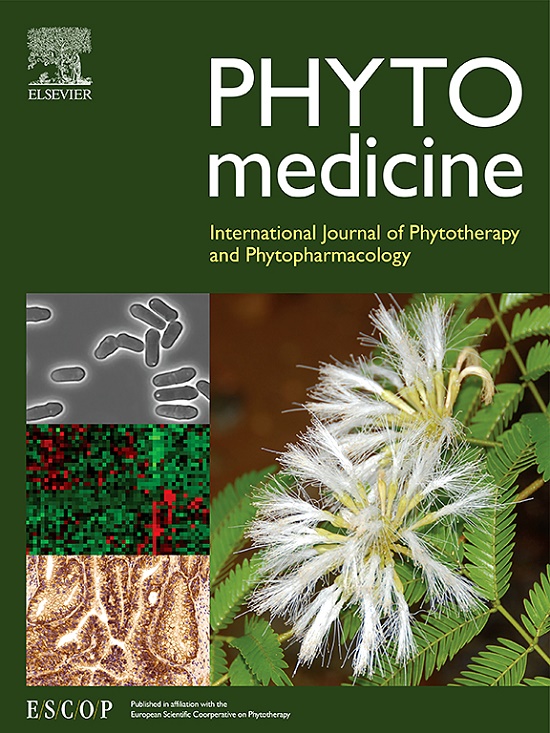Avicularin inhibits ferroptosis and improves cognitive impairments in Alzheimer's disease by modulating the NOX4/Nrf2 axis
IF 8.3
1区 医学
Q1 CHEMISTRY, MEDICINAL
引用次数: 0
Abstract
Background
Alzheimer's disease (AD) is a widespread neurodegenerative disorder for which effective therapies remain elusive, primarily due to the complexity of its underlying pathophysiology. In recent years, natural products have gained attention for their therapeutic potential in AD, owing to their multi-targeted actions and low toxicity profiles. Avicularin (Avi), a flavonoid derived from the peels of Zanthoxylum bungeanum Maxim., has shown promise as an anti-AD agent. However, the specific mechanisms by which Avi mitigates oxidative stress and inhibits ferroptosis in AD models remain insufficiently understood. Further investigation is required to elucidate its therapeutic potential in these pathways.
Purpose
Therefore, this study aims to elucidate the neuroprotective effects of Avi in AD by investigating its impact on the NOX4/Nrf2 signaling pathway, as well as its role in modulating oxidative stress and ferroptosis.
Methods
In this study, an in vitro H2O2-induced oxidative stress model in SH-SY5Y cells was utilized to evaluate the pharmacological efficacy and underlying mechanisms of Avi. Molecular docking, cellular thermal shift assay and bio-layer interferometry assays were conducted to identify potential molecular targets of Avi. Additionally, in vivo models, including scopolamine (SCOP)-induced and APP/PS1 transgenic mice, were employed to assess the cognitive effects of Avi and further explore its associated molecular mechanisms.
Results
Our study demonstrates that Avi effectively attenuates H2O2-induced toxicity in SH-SY5Y cells by reducing apoptosis and enhancing cellular antioxidant defenses. This neuroprotective effect is mediated through the inhibition of NOX4 and the promotion of Nrf2 nuclear translocation. Furthermore, Avi improves cognitive function and mitigates ferroptosis in both SCOP-induced and APP/PS1 transgenic mouse models of AD.
Conclusion
Avi emerges as an effective neuroprotective agent against AD, offering a promising therapeutic approach by targeting the NOX4/Nrf2 signaling axis to alleviate oxidative stress and ferroptosis.
阿维菌素通过调节NOX4/Nrf2轴抑制铁蛋白沉积并改善阿尔茨海默病的认知障碍
背景:阿尔茨海默病(AD)是一种广泛存在的神经退行性疾病,主要由于其潜在病理生理学的复杂性,有效的治疗方法仍然难以找到。近年来,天然产物因其多靶点作用和低毒性特征,在老年痴呆症的治疗潜力方面备受关注。从Zanthoxylum bungeanum Maxim.果皮中提取的黄酮类化合物Avicularin(Avi)已显示出作为抗AD药物的前景。然而,人们对阿维减轻氧化应激和抑制AD模型中铁细胞凋亡的具体机制仍不甚了解。目的:因此,本研究旨在通过研究阿维对 NOX4/Nrf2 信号通路的影响及其在调节氧化应激和铁氧化过程中的作用,阐明阿维对 AD 的神经保护作用:本研究利用体外 H2O2- 诱导的 SH-SY5Y 细胞氧化应激模型来评估阿维的药理作用和内在机制。通过分子对接、细胞热转移测定和生物层干涉测定,确定了阿维的潜在分子靶点。此外,我们还采用了体内模型,包括东莨菪碱(SCOP)诱导的小鼠和APP/PS1转基因小鼠,来评估阿维对认知的影响,并进一步探索其相关的分子机制:我们的研究表明,阿维通过减少细胞凋亡和增强细胞抗氧化防御能力,有效减轻了H2O2诱导的SH-SY5Y细胞毒性。这种神经保护作用是通过抑制 NOX4 和促进 Nrf2 核转位来实现的。此外,阿维还能改善 SCOP 诱导的 AD 模型和 APP/PS1 转基因小鼠模型的认知功能,减轻铁突变:结论:阿维是一种有效的神经保护剂,可通过靶向 NOX4/Nrf2 信号轴来缓解氧化应激和铁蛋白沉积,从而提供一种有前景的治疗方法。
本文章由计算机程序翻译,如有差异,请以英文原文为准。
求助全文
约1分钟内获得全文
求助全文
来源期刊

Phytomedicine
医学-药学
CiteScore
10.30
自引率
5.10%
发文量
670
审稿时长
91 days
期刊介绍:
Phytomedicine is a therapy-oriented journal that publishes innovative studies on the efficacy, safety, quality, and mechanisms of action of specified plant extracts, phytopharmaceuticals, and their isolated constituents. This includes clinical, pharmacological, pharmacokinetic, and toxicological studies of herbal medicinal products, preparations, and purified compounds with defined and consistent quality, ensuring reproducible pharmacological activity. Founded in 1994, Phytomedicine aims to focus and stimulate research in this field and establish internationally accepted scientific standards for pharmacological studies, proof of clinical efficacy, and safety of phytomedicines.
 求助内容:
求助内容: 应助结果提醒方式:
应助结果提醒方式:


